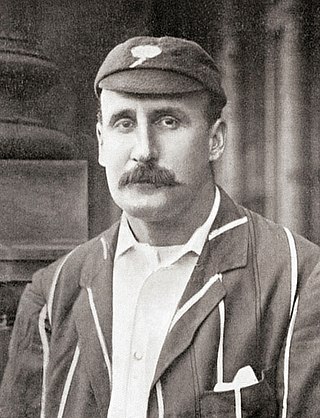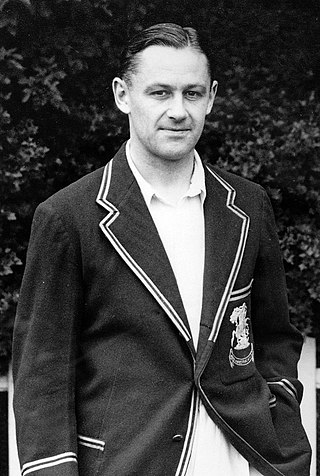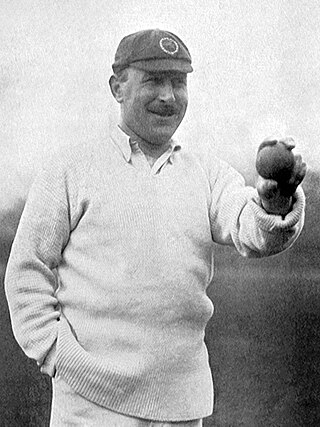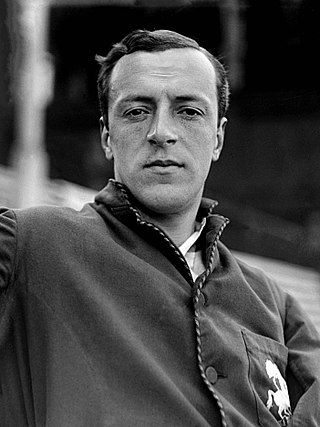
Colonel George Robert Canning Harris, 4th Baron Harris,, generally known as Lord Harris, was a British colonial administrator and Governor of Bombay, best known for developing cricket administration via Marylebone Cricket Club (MCC).

Martin Bladen Hawke, 7th Baron Hawke, generally known as Lord Hawke, was an English amateur cricketer active from 1881 to 1911 who played for Yorkshire and England. He was born in Willingham by Stow, near Gainsborough, Lincolnshire, and died in Edinburgh. He appeared in 633 first-class matches, including five Test matches, as a righthanded batsman, scoring 16,749 runs with a highest score of 166 and held 209 catches. He scored 13 centuries and 69 half-centuries.

Sir George Oswald Browning "Gubby" Allen CBE was a cricketer who captained England in eleven Test matches. In first-class matches, he played for Middlesex and Cambridge University. A fast bowler and hard-hitting lower-order batsman, Allen later became an influential cricket administrator who held key positions in the Marylebone Cricket Club (MCC), which effectively ruled English cricket at the time; he also served as chairman of the England selectors.

Norman Walter Dransfield Yardley was an English cricketer who played for Cambridge University, Yorkshire County Cricket Club and England, as a right-handed batsman and occasional bowler. An amateur, he captained Yorkshire from 1948 to 1955 and England on fourteen occasions between 1947 and 1950, winning four Tests, losing seven and drawing three. Yardley was named Wisden Cricketer of the Year in 1948, and in his obituary in Wisden Cricketers' Almanack he was described as Yorkshire's finest amateur since Stanley Jackson.

Wilfred Rhodes was an English professional cricketer who played 58 Test matches for England between 1899 and 1930. In Tests, Rhodes took 127 wickets and scored 2,325 runs, becoming the first Englishman to complete the double of 1,000 runs and 100 wickets in Test matches. He holds the world records both for the most appearances made in first-class cricket, and for the most wickets taken (4,204). He completed the double of 1,000 runs and 100 wickets in an English cricket season a record 16 times. Rhodes played for Yorkshire and England into his fifties, and in his final Test in 1930 was, at 52 years and 165 days, the oldest player who has appeared in a Test match.

George Herbert Hirst was a professional English cricketer who played first-class cricket for Yorkshire County Cricket Club between 1891 and 1921, with a further appearance in 1929. One of the best all-rounders of his time, Hirst was a left arm medium-fast bowler and right-handed batsman. He played in 24 Test matches for England between 1897 and 1909, touring Australia twice. He completed the double of 1,000 runs and 100 wickets in an English cricket season 14 times, the second most of any cricketer after his contemporary and team-mate Wilfred Rhodes. One of the Wisden Cricketers of the Year for 1901, Hirst scored 36,356 runs and took 2,742 wickets in first-class cricket. In Tests, he made 790 runs and captured 59 wickets.
Gentlemen v Players was a long-running series of cricket matches that began in July 1806 and was abolished in January 1963. It was a match between a team consisting of amateurs and a team consisting of professionals that reflected the English class structure of the 19th century. Typically, the professionals were working class people who earned their living by playing cricket, while the amateurs were middle- and upper-class products of the public school system, who were supposedly unpaid for playing. The professionals were paid wages by their county clubs and/or fees by match organisers, while the amateurs claimed expenses. However, while rules to distinguish amateurs from professionals were established by Marylebone Cricket Club (MCC), the system of allowable expenses was both controversial and complex, enabling some leading amateurs to be paid more than any professional for playing cricket.
Arthur Haygarth was a noted amateur cricketer who became one of cricket's most significant historians. He played first-class cricket for the Marylebone Cricket Club and Sussex between 1844 and 1861, as well as numerous other invitational and representative teams including an England XI and a pre-county Middlesex. A right-handed bat, Haygarth played 136 games now regarded as first-class, scoring 3,042 runs and taking 19 wickets with his part-time bowling. He was educated at Harrow, which had established a rich tradition as a proving ground for cricketers. He served on many MCC committees and was elected a life member in 1864.
In English cricket, the years 1826–1845 were dominated by the roundarm bowling issue, which was resolved when the style was legalised in 1835, and by the formation of the first modern county clubs between 1839 and 1845.
The University Match in a cricketing context is generally understood to refer to the annual fixture between Oxford University Cricket Club and Cambridge University Cricket Club.
All first-class cricket was cancelled in the 1940 to 1944 English cricket seasons because of the Second World War; no first-class matches were played in England after Friday, 1 September 1939 until Saturday, 19 May 1945.

Francis Marchant, known as Frank Marchant, was an English amateur cricketer. He was a right-handed batsman, an occasional wicket-keeper and the captain of Kent County Cricket Club from 1890 to 1897.
Andrew Marshall Porter was an Irish barrister who was killed in the Second Boer War while fighting for the Imperial Yeomanry. He was also a noted sportsman, representing Ireland at both cricket and field hockey.
Cricket, and hence English amateur cricket, probably began in England during the medieval period but the earliest known reference concerns the game being played c.1550 by children on a plot of land at the Royal Grammar School, Guildford, Surrey. It is generally believed that cricket was originally a children's game as it is not until the beginning of the 17th century that reports can be found of adult participation.
Guy Rolf Jackson was an English cricketer who played first-class cricket for Derbyshire between 1919 and 1936, being captain for nine years.
Guy Fife Earle was an English cricketer who played first-class cricket for Surrey and Somerset for 20 years before and after the First World War. He also played in India, Sri Lanka, Australia and New Zealand as a member of official Marylebone Cricket Club touring teams, though he did not play Test cricket.
Robert St Leger Fowler was an Irish first-class cricketer, often regarded as the best Irish cricketer not to have represented Ireland itself. An all-rounder who batted right-handed and bowled off spin, he is perhaps best known for his outstanding all-round performance as captain of Eton College in the match against Harrow in 1910, the match commonly referred to as Fowler's match. After serving in the First World War with the 17th Lancers, during the course of which he was awarded the Military Cross, Fowler played first-class cricket after the war mostly for the British Army cricket team, until his death from leukemia in 1925.
Fowler's match is the name given to the two-day Eton v Harrow cricket match held at Lord's on Friday 8 and Saturday 9 July 1910. The match is named after the captain of Eton College, Robert St Leger Fowler, whose outstanding all round batting and bowling performance allowed Eton to win the match by 9 runs after Harrow School asked Eton to follow on 165 runs in arrears after the teams' first innings. When the ninth Eton wicket fell in their second innings, they led by only four runs, and Harrow's eventual target was just 55. Wisden stated that: "In the whole history of cricket, there has been nothing more sensational" and The Times said that "A more exciting match can hardly ever have been played", continuing effusively, with a reference to the inaugural Ashes Test at The Oval in 1882, "to boys the bowling of Fowler was probably more formidable than Spofforth's to England".

Bernard James Tindal Bosanquet was an English cricketer best known for inventing the googly, a delivery designed to deceive the batsman. When bowled, it appears to be a leg break, but after pitching the ball turns in the opposite direction to that which is expected, behaving as an off break instead. Bosanquet, who played first-class cricket for Middlesex between 1898 and 1919, appeared in seven Test matches for England as an all-rounder. He was chosen as a Wisden Cricketer of the Year in 1905.
Through the Napoleonic Wars, county cricket virtually died as cricket was impacted by losses of investment and manpower.







